Testosterone Replacement Therapy Market Research, 2032
The global testosterone replacement therapy market size was valued at $1.9 billion in 2022, and is projected to reach $2.9 billion by 2032, growing at a CAGR of 4.2% from 2023 to 2032. Testosterone replacement therapy is a medical intervention used to address low testosterone levels in individuals, typically men. It involves administering synthetic or bioidentical testosterone to restore hormonal balance. According to 2023 report by National Library of Medicine it was reported that hypogonadism occurs in 19% of men in their 60s, 28% of men in their 70s, and 49% of men in their 80s. In addition, according to the World Health Organization, it was reported that by 2030, 1 in 6 people in the world are expected to be aged 60 years or over. Furthermore, according to a 2023 report by the National Library of Medicine, it was reported that hypogonadism is common in geriatric patients.
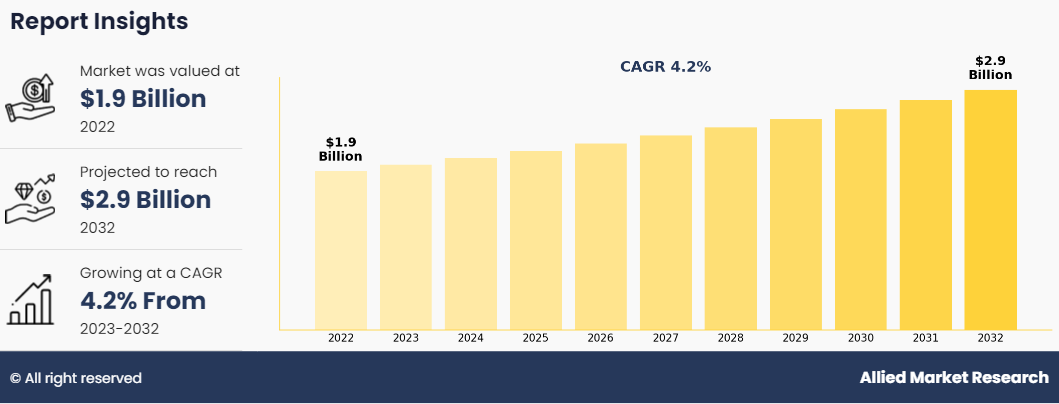
Testosterone replacement therapy (TRT) is a medical intervention designed to address low testosterone levels in individuals, particularly men. Testosterone, a key male sex hormone, plays a crucial role in various bodily functions, including the development of secondary sexual characteristics, maintaining bone density, muscle mass, and energy levels. When testosterone levels decline due to aging, medical conditions, or other factors, individuals experience symptoms such as fatigue, reduced libido, mood swings, and diminished cognitive function. Testosterone replacement therapy aims to restore testosterone levels to normal ranges, alleviating these symptoms and potentially improving overall well-being. Common methods of administering testosterone replacement therapy include injections, patches, gels, or implants.
Key Takeaways
- On the basis of product type, the injectable segment dominated the testosterone replacement therapy market share in terms of revenue in 2022. However, the other segment is expected to register the highest CAGR during the forecast period.
- On the basis of active ingredient, the testosterone cypionate segment dominated the market share in 2022. However, testosterone undecanoate segment is expected to register highest CAGR during the forecast period.
- On the basis of end user, the clinics segment dominated the market in terms of revenue in 2022 and is expected to register fastest growth during the forecast period.
- On the basis of region, North America dominated the market in terms of revenue in 2022. However, Asia-Pacific is anticipated to grow at the highest CAGR during the forecast period.
Market Dynamics
The testosterone replacement therapy market is expected to grow significantly owing to rise in prevalence of hypogonadism, rise in awareness about men health and overall wellbeing, and rise in geriatric population.The significant surge in the prevalence of hypogonadism has emerged as a primary driver for the remarkable growth of the testosterone replacement therapy market. Hypogonadism, characterized by insufficient testosterone production, affects a substantial portion of the male population, leading to a various symptom such as fatigue, decreased libido, and mood disturbances. According to the 2021 report by Acerus Pharmaceuticals, a specialty pharmaceutical manufacturer, it was estimated that approximately 481,000 new cases of hypogonadism per year in men aged 40-69 years in the U.S. Thus, the surge in prevalence of hypogonadism is expected to drive the growth of testosterone replacement therapy industry.
In addition, according to testosterone replacement therapy market forecast analysis a rise in awareness about mens health and overall well-being is expected to drive the growth of the market. With growing attention to the importance of maintaining optimal health among men, there has been a heightened focus on addressing conditions such as hypogonadism and age-related decline in testosterone levels. Men have become increasingly proactive in seeking solutions to improve their quality of life and combat symptoms associated with low testosterone levels, including fatigue, reduced libido, and decreased muscle mass. Moreover, a shift in societal attitudes toward destigmatizing discussions surrounding men's health issues has encouraged more open dialogue and acceptance of treatments such as testosterone replacement therapies. This cultural shift has increased awareness and facilitated greater acceptance and accessibility of testosterone replacement therapies. Thus, the growing awareness and concers about men's health is expected to present significant testosterone replacement therapy market opportunity for growth.
Moreover, the insurance coverage available on the testosterone replacement therapy is expected to contribute significantly to the testosterone replacement therapy market growth. As awareness of hormonal imbalances and related health issues has increased, more individuals are seeking medical interventions such as testosterone replacement therapy to address low testosterone levels. The accessibility and affordability of testosterone replacement therapy has been influenced by the extent of insurance coverage available to patients. Insurance providers recognizing the medical necessity of testosterone replacement therapy for individuals with clinically diagnosed low testosterone levels have facilitated broader access to these treatments, making them more financially feasible for a larger demographic. This expanded coverage of insurance has encouraged more men to explore and opt for testosterone replacement therapy and enabled healthcare providers to offer comprehensive and personalized treatment plans. In addition, insurance support has led to increased collaboration between healthcare professionals and insurers, fostering a more integrated and streamlined approach to testosterone replacement therapy. Thus, the insurance coverage for testosterone replacement therapy is expected to drive the growth of testosterone replacement therapy market size.
Segments Overview
The testosterone replacement therapy market is segmented on the basis of product type, active ingredient, end user, and region. By product type, the market is classified into injectables, topical, and others. Other product types include oral, implant, and intranasal formulations. By active ingredient, the market is divided into testosterone cypionate, testosterone, testosterone enanthate, testosterone undecanoate, others. By end user, it is segregated into hospitals, and clinics.
Region-wise, the market is analyzed across North America (the U.S., Canada, and Mexico), Europe (Germany, France, the UK, Italy, Spain, and rest of Europe), Asia-Pacific (Japan, China, Australia, India, South Korea, and rest of Asia-Pacific), LA (Brazil, Colombia, Argentina, and rest of LA), and MEA (GCC, South Africa, North Africa, and rest of MEA).
By Product Type
The injectables segment dominated the market share in 2022, owing to cost effectiveness and greater bioavailability. However, according to testosterone replacement therapy market trends analysis the other segment is expected to register fastest growth owing to increasing adoption of implants owing to its prolonged and controlled release of testosterone in the body.
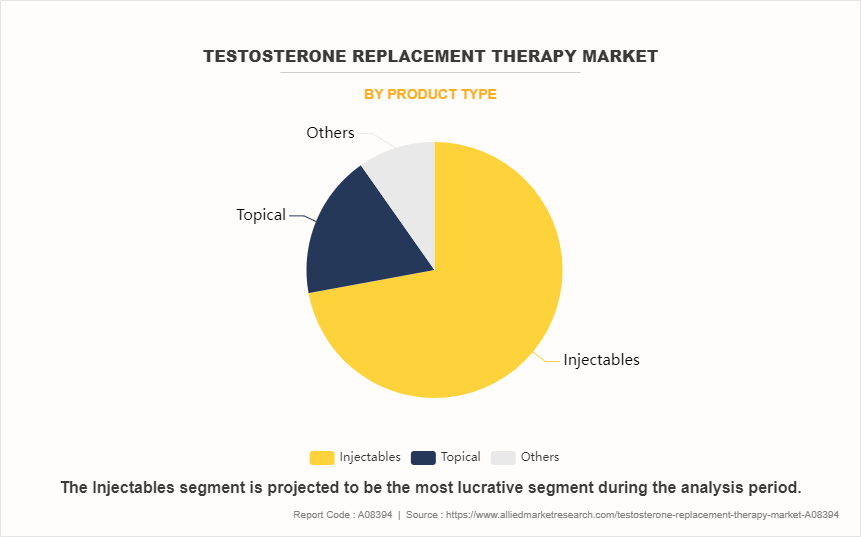
By Active Ingredient
The testosterone cypionate segment dominated the testosterone replacement therapy market share in 2022. This is attributed to the high adoption of the testosterone cypionate by medical professionals owing to its high effectivity. However, according to testosterone undecanoate segment is expected to register highest CAGR during the forecast period, owing to the availability of testosterone undecanoate in both injectable and oral dosage form.
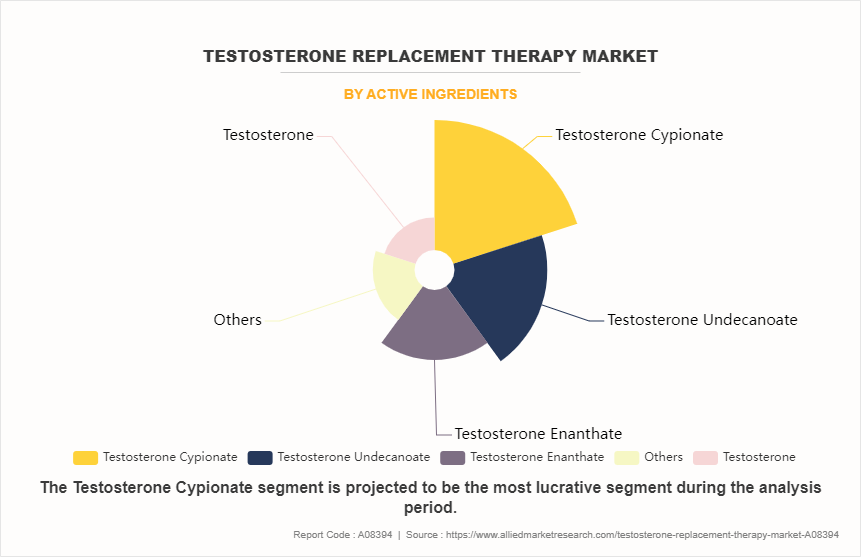
By End User
The clinics segment dominated the global testosterone replacement therapy market share in 2022, owing to the fact that the specialty clinics such as urology clinics cater large male patient base and provide testosterone replacement therapy to the patients.
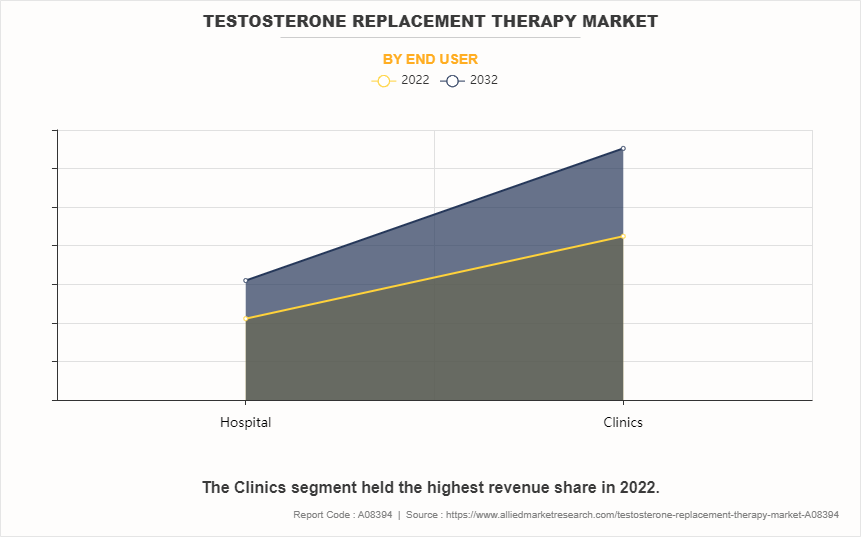
By Region
The testosterone replacement therapy market is analyzed across North America, Europe, Asia-Pacific, LA, and MEA. North America accounted for a major share of the testosterone replacement therapy market in 2022 and is expected to maintain its dominance during the forecast period. This is attributed to the strong presence of major key players, rise in geriatric population, and well-developed healthcare facilities which provide necessary infrastructure for the testosterone replacement therapy. However, according to testosterone replacement therapy market forecast analysis the Asia-Pacific Region is expected to register the highest CAGR during the forecast period owing to rise in incidence of hypogonadism and unhealthy lifestyle of peoples, which have led to the lower levels of testosterone.
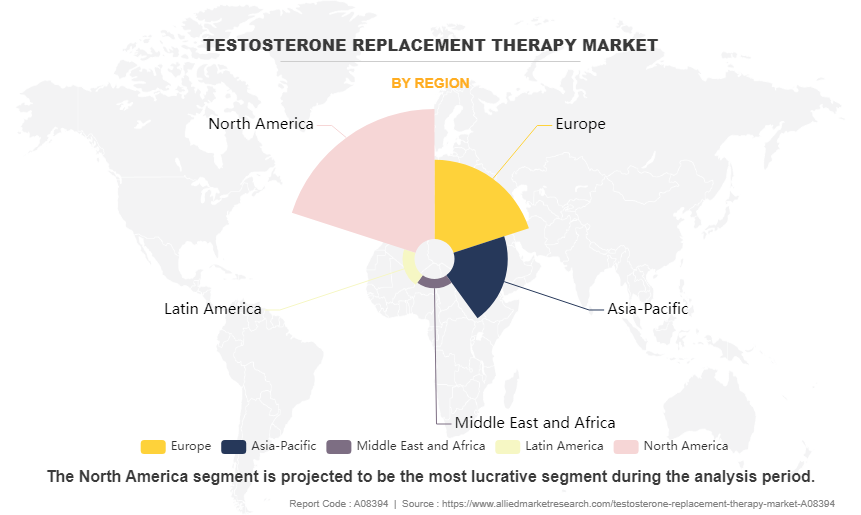
Competitive Analysis
Competitive analysis and profiles of the major players in testosterone replacement therapy market, such as AbbVie Inc, Besins Healthcare SA, Acerus Pharmaceuticals Corporation, Amneal Pharmaceuticals Inc., Acrux Ltd., Endo International Plc, Biote Medical, LLC, Pfizer Inc., Insud Pharma S.L, and Marius Pharmaceuticals are provided in this report. Major players have adopted acquisition and product approval as a key developmental strategy to improve the product portfolio of the testosterone replacement therapy market.
Recent Developments in Testosterone Replacement Therapy Industry
- In February 2021, Simple Pharma acquired Testavan and Vitaros, two established mens health brands, from Ferring. Testavan (transdermal testosterone gel 2%) is a testosterone replacement therapy for adult male hypogonadism, when testosterone deficiency has been confirmed by clinical features and biochemical tests. Vitaros (alprostadil cream) is the only topical cream that treats Erectile Dysfunction (ED).
- In August 2022, Marius Pharmaceuticals, a patient-centric healthcare company, announced the approval of Kyzatrex (testosterone undecanoate) by the U.S. Food and Drug Administration (FDA). Kyzatrex is an oral testosterone replacement therapy indicated in adult males for conditions associated with a deficiency or absence of endogenous testosterone, also known as hypogonadism.
Key Benefits for Stakeholders
- This report provides a quantitative analysis of the market segments, current trends, estimations, and dynamics of the testosterone replacement therapy market analysis from 2022 to 2032 to identify the prevailing testosterone replacement therapy market opportunities.
- The market research is offered along with information related to key drivers, restraints, and opportunities.
- Porter's five forces analysis highlights the potency of buyers and suppliers to enable stakeholders make profit-oriented business decisions and strengthen their supplier-buyer network.
- In-depth analysis of the testosterone replacement therapy market segmentation assists to determine the prevailing market opportunities.
- Major countries in each region are mapped according to their revenue contribution to the global market.
- Market player positioning facilitates benchmarking and provides a clear understanding of the present position of the market players.
- The report includes the analysis of the regional as well as global testosterone replacement therapy market trends, key players, market segments, application areas, and market growth strategies.
Testosterone Replacement Therapy Market Report Highlights
| Aspects | Details |
| Forecast period | 2022 - 2032 |
| Report Pages | 270 |
| By Product Type |
|
| By Active ingredients |
|
| By End User |
|
| By Region |
|
| Key Market Players | Amneal Pharmaceuticals Inc., Insud Pharma S.L, Acerus Pharmaceuticals Corporation, Biote Medical LLC, Marius Pharmaceuticals, Endo International plc., AbbVie Inc., Pfizer Inc., Acrux Ltd., Besins Healthcare SA |
Analyst Review
This section provides various opinions of testosterone replacement therapy market. The testosterone replacement therapy market has experienced substantial growth, driven by an increasing awareness of testosterone deficiency and its associated health implications. Factors such as an aging population, rising prevalence of hypogonadism, and lifestyle changes contribute to the expanding demand for testosterone replacement therapy. The testosterone replacement therapy market has witnessed advancements in treatment options, including innovative delivery systems such as transdermal patches, gels, and long-acting injections, enhancing patient convenience and compliance.
Moreover, North America accounted for the largest share in 2022. This is attributed to the strong presence of major key players and growth in the aging population. However, Asia-Pacific is anticipated to witness notable growth owing to rise in prevalence of hypogonadism and surge in incidence of low testosterone owing to unhealthy lifestyle.
The forecast period for testosterone replacement therapy market is 2023 to 2032.
North America is the largest regional market for testosterone replacement therapy.
The base year is 2022 in testosterone replacement therapy market.
The estimated industry size of testosterone replacement therapy in 2032 is $2.9 billion.
Top companies in testosterone replacement therapy market are AbbVie Inc, Besins Healthcare SA, Acerus Pharmaceuticals Corporation, and Amneal Pharmaceuticals Inc.
Asia-Pacific region is expected to be fastest growing region in testosterone replacement therapy market.
Testosterone replacement therapy (TRT) is a medical intervention used to treat individuals with low levels of testosterone, a hormone produced primarily in the testicles.
Rise in prevalence of hypogonadism and the rising incidence of chronic diseases such as obesity, diabetes, and metabolic syndrome are the factors responsible for the market growth.
Loading Table Of Content...
Loading Research Methodology...


